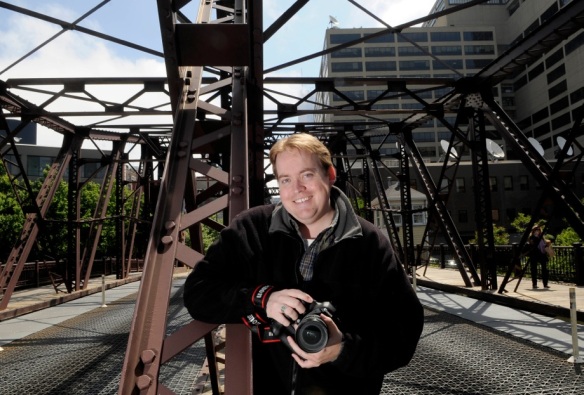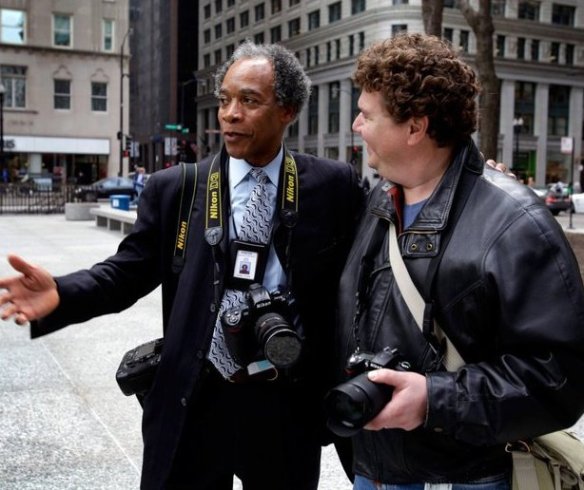‘The most pathetic person in the world is someone who has sight, but has no vision.” – Helen Keller.
I have been on a slow burn for a week now. I am no less angry about the Sun-Times firing their entire photo staff today than I was a week ago. This blog entry has started and stopped numerous times as I try to find a focus to my thoughts and emotions.
One of the advantages of waiting a week to write this blog is that I have had the pleasure of watching the 28 Sun-Times photographers be such great standard bearers for our profession. In my 24-years as a member of the Illinois Press Photographers Association I have never felt more a part of our organization. We are all spread out across the state and on many days we are competing for the same stories and in the same contests. But as a result of the Sun-Times actions we are a cohesive unit led by our president Rob Hart.
I am not going to pretend that I know all of the 28 photographers personally. My one close friend on the staff is Brett Roseman, a former Dispatch/Argus intern. It pains me to see this happen to Brett, not to mention another former intern and friend, Marianne Morgan, who was laid off from the Sun-Times in a prior downsizing.

Davenport native Brett Roseman was one of the 28 photographers who lost their jobs when Chicago Sun-Times fired its entire photo staff. Roseman is a former Dispatch/Argus photo intern. Photo courtesy of Matt Marton
I grew up in the Chicago suburbs and some of those laid off photogs were there making amazing photos when I was in high school. One in particular, Pulitzer Prize winner John H. White, was the person who lit the fuse for my career in photojournalism. In about 1980 JHW came to speak at my high school and his passion and skill for photography were way beyond inspiring. I knew right then and there that I wanted to be a photojournalist.

John H. White with one of my former interns Eric Davis of the Chicago Tribune. (Photo courtesy of Eric Davis)
So on that fateful day when I got wind of the firings, I could not believe my eyes when I saw Rob Hart’s Instagram post http://instagram.com/p/Z8MuF-w7ff/ about being fired along-side his hero John H. White. The gravity of the situation still didn’t sink in until I spoke with Brett. Unfortunately I was the first person to inform Brett of the mass firings. He was unable to attend the staff meeting where the Sun-Times officials unceremoniously jettisoned their entire photo staff. According to Brett he had an inkling something was amiss when the meeting was called but who could have ever imagined a wholesale layoff?
I have had friends laid off before but this is something completely different. What the Sun-Times did was unprecedented and a direct shot right across the bow of photojournalism. It is an insult to readers and the paper’s advertisers. There are all sorts of theories as to why they did it. But even if they have some grand Machiavellian plan it doesn’t change the fact that eliminating their award winning photo staff for any reason was a colossal mistake. I think Alex Garcia of the Chicago Tribune does a fantastic job of detailing “The Idiocy of Eliminating a Photo Staff” in his Assignment Chicago blog .
PRESS RELEASE: “The Sun-Times business is changing rapidly and our audiences are consistently seeking more video content with their news. We have made great progress in meeting this demand and are focused on bolstering our reporting capabilities with video and other multimedia elements. The Chicago Sun-Times continues to evolve with our digitally savvy customers, and as a result, we have had to restructure the way we manage multimedia, including photography, across the network.”
After that was released their plan to train reporters in the basics of iPhone photography quickly leaked out and the mocking quickly followed.
Colbert Report mocks the Sun-Times
It’s comical to think that the Sun-Times customers, especially their 20-something readers, are going to be willing to sit through an endless stream of shaky 30-second video clips. Kids love video but not boring video of the Chicago City Council droning on about whatever. If I have learned anything in the last 5-plus years of producing multimedia/video is that quality content matters to our customers. Who produces great video? Great visual journalists – go figure.
I am not surprised when people take what we do for a living for granted. At the start of the digital revolution, when our darkrooms were replaced by Macs I had a former news editor look me in the eye with a cold dead stare and say, “You know we’re gonna replace you guys someday with reporters with cameras and no one will notice.” Strangely during our time together he seemed to understand the importance of good pictures. I guess he just didn’t understand how difficult it was to go get them.
Thankfully for me and my staff our bosses understand strong visuals. Every news meeting begins with a discussion about the photos. We are lucky and my staff and I know it.
I think deep down most people understand that the images matter because every time I have covered a story which involves someone losing their home – as long as their family is OK – the first thing they mourn are their family photos. Their visual link to the past has been severed by a fire or a tornado. They can rebuild the house but the photos are irreplaceable.
When you think of events like 9/11 it’s the images that people remember. The images of people running in horror from the collapsing buildings or the heroic firefighters raising the flag over Ground Zero are seared into our consciousness. John H. White expressed this same idea in an interview with CNN last week while talking about the importance of photojournalism. “It’s the visual and for a lot of people 100-years from now, it’s their only connection with history. We’re visual historians.”
TWO HANDS – ONE BRAIN
On the day I was hired at the D/A I was asked by an acquaintance what my new job was going to be. When I told them ‘a photographer’ the person said: “That’s all? They are going to pay you to just take photos?”
I think about that conversation when I am trying to juggle shooting stills, getting video, doing an interview and keeping my head on a swivel so I don’t miss something important. Most of those duties are visual tasks so they come fairly easily to me.
But, trying to be both a reporter and photographer at a busy news scene is sort of like knitting a sweater while scrambling eggs. Neither one is going to turn out right and you’re probably going to get burned.
Reporters and photographers think differently because they utilize different regions of their brains. A reporter’s job is to collect as much information as possible to tell the story. The photographer’s job is to capture that split second moment in time which incapsulates the story.
Henri Cartier-Bresson, the father of modern photojournalism, referred to it as the decisive moment. “There is nothing in this world that does not have a decisive moment.” “To me, photography is the simultaneous recognition, in a fraction of a second, of the significance of an event as well as of a precise organization of forms which give that event its proper expression.”
It is impossible for me to imagine a world without the photographers brave enough to point their cameras into the face of history and hold focus. But let me be clear, all history is not confined to war-zones and conflict. Our history encompasses everything from a high school soccer game to a presidential election and beyond.
I know that to someone who has been laid off by GM this must all sound so ridiculous. I understand that photojournalists don’t cure cancer but what we do is keep focus on those who are afflicted and try to lend some valuable human insight into the disease for everyone else.
The layoffs have been a gut punch to our profession but by no means is photojournalism dead. The 28 talented photographers and all those who were laid off in the years leading up to this move will survive because by their very nature they are curious and adaptable. As John H. White said to CNN – “Those whose visions and values are different can’t extinguish the light of hope.” For we are the “lamplighters to the world.”
Here are a few excellent articles and blogs in this topic which are worth the read.
‘Assignment Chicago’ by Alex Garcia “The Idiocy of Eliminating a Photo Staff”
‘Shooting from the Hip’ by Scott Strazzante “Are you just the photographer?
‘Laid off from the Sun-Times’ Rob Hart : Laid off from the Sun-Times
Phil Greer – http://jimromenesko.com/2013/06/06/angry-chicago-photographer-blasts-sun-times-for-layoffs/
Rob Hart on WGN – http://wgnradio.com/2013/06/03/fired-photog-details-sun-times-eliminating-photojournalism-staff/
American Photo – The Sun-Times Photo Layoffs: What We’re Losing

